Символическая ссылка (симлинк, символьная ссылка, Symbolic link) это специальный файл на файловой системе, которые сам не содержит данных, а является по сути ярлыком, указывающим на какой-то другой объект (файл или папку). При обращении к симлику операционная система считает, что это оригинальный файл (папка) и работает с ними совершенно прозрачно.
Символические ссылки используются в Windows довольно часто для системных файлов и каталогов. Пользователь может их применять, когда нужно перенести часть “тяжелых” файлов на другой диск, но чтобы Windows считала, что файлы все еще находятся в исходном каталоге (например в ситуациях, когда нужно экономить место на SSD, перенеся некоторые каталоги на более медленный и емкий SSD, не нарушая работоспособности программ). Можно использовать симлинки на SMB файловом сервере, когда каталоги с разных LUN должны быть доступны через одну точку входа.
В Windows есть три типа файловых ссылок для NTFS томов: жесткие, мягкие (симлинки), точки соединения (Junction point).
- Hard Links (жесткие ссылки) – могут указывать только на локальный файл, но не на папку. Такой файл – это ссылка на другой файла на этом же диске без фактического дублирования самого файла. У него отображается такой же размер и свойства, как у целевого файла (но реальное место на диске он не занимает);
- Junction Points (Directory Hard Link, точка соединения) – могут указывать только на папку (на этом же или на другом разделе);
- Symbolic Links (мягкая ссылка, симлинк) – могут указывать на локальный файл, папку и сетевой каталог на удаленном компьютере (UNC), поддерживаются относительные пути.
В подавляющем большинстве случаев вам будет достаточно функционала symbolic link, как наиболее универсального средства создания ссылки на любой объект.
Как создать символическую ссылку в Windows?
Для создания символических и жестких ссылок в Windows можно использовать встроенную утилиты mklink или PowerShell.
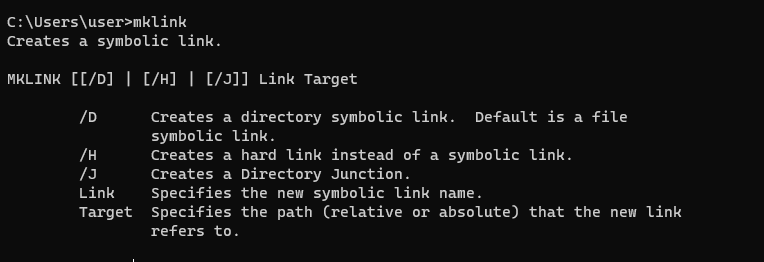
Синтаксис у утилиты
mklink
простой. Чтобы создать символическую ссылку на файл, нужно указать имя ссылки и целевой объект, на который она должна указывать. Можно указать тип ссылки:
/D
— символьная (мягкая) ссылка на каталог,
/H
— жесткая ссылка,
/J
– точка соединения (Junction point).
Чтобы использовать mklinkдля создания символических ссылок нужно запустить командную строку с правами администратора. Иначе при запуске команды появится ошибка “
You do not have sufficient privilege to perform this operation
”.
Если вам нужно разрешить создавать символические ссылки обычным пользователям, нужно добавить группу пользователей в параметр групповой политики Create Symbolic Links (Computer configuration -> Window Settings -> Security settings -> User Rights Assignment в редакторе GPO). По умолчанию в этой политике добавлена только локальная группа «Administrators». Обновите локальные политики после изменения параметра: gpupdate /force
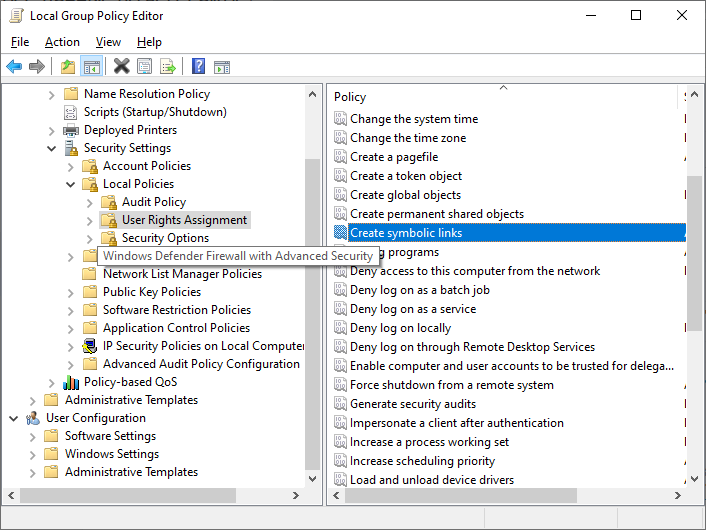
Создадим в каталоге C:\PS символическую ссылку на файл notepad.exe:
mklink C:\PS\note.exe c:\Windows\System32\notepad.exe
Должно появится сообщение:
symbolic link created for C:\PS\note.exe <<===>> c:\Windows\System32\notepad.exe
Теперь для запуска процесса notepad.exe можно использовать символическую ссылку note.exe.
Теперь создадим в этом каталоге симлинк на другой каталог на этом же диcке:
mklink /D “C:\PS\Downloads” “C:\Users\user\Downloads”

Теперь при переходе в каталог C:\PS\Downloads вы будете видеть содержимое каталога, на который он ссылается.

Выведем содержимое каталога C:\PS:
Dir c:\ps
Как вы видите, в атрибутах некоторых файлов указано, что это symlink/simlinkd. Также указан объект, на который они ссылаются. В Windows File Explorer симлинки отображаются с иконками ярлыков, а в их свойствах можно посмотреть целевой объект на который они ссылаются.
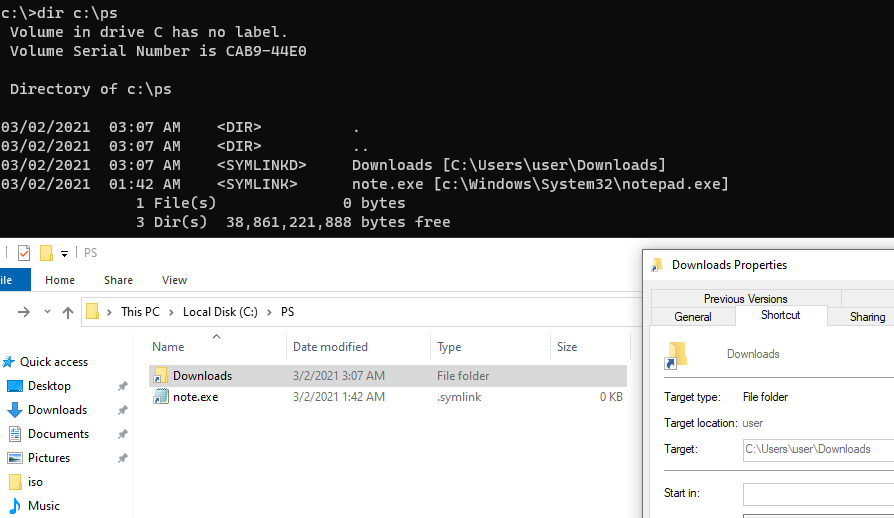
Также можно создать символически ссылки в Windows 10 с помощью PowerShell (в этом примере я использую относительные пути, чтобы создать символическую ссылку):
New-Item -ItemType SymbolicLink -Path ".\test\tmpfiles" -Target "..\tmp\files"

Можно создать символическую ссылку на сетевую папку на удаленном компьютере/сервере. Адрес сетевой папки нужно указывать в формате UNC. Следующий пример создаст симлинк на сетевой каталог на сервере:
mklink /D c:\ps\share \\mskfs01\Share
Например, подключим административную шару C$ с удаленного компьютера по IP адресу:
mklink /D c:\remotePC\server1 \\192.168.31.15\С$
Если при доступе к сетевой папке через симлинк, вы получили ошибку
The symbolic link cannot be followed because its type is disabled
проверьте разрешенные способы использования символических ссылок на вашем компьютере:
fsutil behavior query SymlinkEvaluation
Local to local symbolic links are enabled. Local to remote symbolic links are enabled. Remote to local symbolic links are disabled. Remote to remote symbolic links are disabled.

Чтобы включить использование символических ссылок на удаленные ресурсы, выполните команды:
fsutil behavior set SymlinkEvaluation R2R:1
fsutil behavior set SymlinkEvaluation R2L:1
Вы можете работать с символическими ссылками, как с обычными объектами файловой системы, можно переименовать, переносить или удалить их. Система автоматически изменит настройки таких симлинков, чтобы они указывали на верные целевые объекты.
Для удаления симлинков используются обычные команды, как и для удаления файлов:
Del c:\ps\note.exe
RD c:\ps\downloads
Как найти и вывести все символические ссылки на диске?
В Windows нет простых инструментов для просмотра и управления всеми симлинками на диске.
Вы можете вывести список всех символических ссылок на диске с помощью команды:
dir /AL /S C:\ | find "SYMLINK"
-
/A
– вывести файлы с атрибутом L (симлинк); -
/S
–выполнить команду рекурсивно для всех вложенных каталогов; -
C:\
— укажите имя диска, на котором нужно найти все символические ссылки (если вы не хотите сканировать весь диск, укажите путь к нужному каталогу)

Также можно вывести список всех символических ссылок на диске с помощью PowerShell. Для этого нужно просканировать все каталоги и найти NTFS объекты с атрибутом ReparsePoint:
Get-ChildItem -Path C:\ -Force -Recurse -ErrorAction 'silentlycontinue' | Where { $_.Attributes -match "ReparsePoint"}
Жесткие и символические ссылки давно знакомы и активно используются Linux-администраторами, в то время как их Windows коллеги используют их гораздо реже, а некоторые вообще не знают о такой возможности. Тем не менее такая возможность в Windows существует и позволяет значительно упростить некоторые сценарии работы с папками и файлами. В данной статье мы рассмотрим все виды ссылок, доступные в среде ОС Windows, а также разные способы работы с ними, начиная от командной строки и заканчивая PowerShell.
Онлайн-курс по устройству компьютерных сетей
На углубленном курсе «Архитектура современных компьютерных сетей» вы с нуля научитесь работать с Wireshark и «под микроскопом» изучите работу сетевых протоколов. На протяжении курса надо будет выполнить более пятидесяти лабораторных работ в Wireshark.
Жесткие ссылки (HardLink)
Жесткие ссылки представляют собой дополнительную запись в файловой таблице раздела для существующего файла. Таким образом жесткая ссылка ничем не отличается от исходного файла, но файл при этом не копируется физически и остается на диске в единственном экземпляре. При изменении файла по любой из жестких ссылок, остальные обновляются автоматически (что логично, так как файл один).
Мы можем переименовывать, копировать, перемещать (в пределах логического тома) ссылки — размер занимаемого места при этом не изменится. При удалении ссылок файл продолжает существовать до тех пор, пока не будет удалена последняя жесткая ссылка на него. Фактически отличить, где находится оригинальный файл, а где жесткая ссылка невозможно, по сути, файл на разделе это и есть жесткая ссылка.
Жесткая ссылка может существовать только в пределах логического тома, поддерживается файловыми системами NTFS и ReFS начиная со сборки 19536.
Для создания жесткой ссылки можно воспользоваться утилитой mklink:
mklink /H C:\Folder1\LinkFileName C:\Folder\FileNameГде ключ /H предписывает создать именно жесткую ссылку, далее следует путь к новому файлу и целевому файлу, на который мы делаем ссылку. Путь можно указывать как абсолютные, так и относительные, в имени создаваемого файла не забывайте указывать расширение.

Ссылки можно создавать и при помощи PowerShell, для этого воспользуйтесь командой:
New-Item -ItemType HardLink -Path C:\Folder1\LinkFileName -Target C:\Folder\FileNameКоманда другая, но принцип тот же самый: -ItemType — тип создаваемой ссылки, в нашем случае жесткая ссылка, -Path — путь к создаваемому файлу ссылки, -Target — файл на который мы делаем ссылку.

Можно ли сделать жесткую ссылку на директорию? Нет, только на файлы.
Вроде бы все понятно, но если внимательный читатель заглянет в свойства папки с жесткой ссылкой, то он увидит, что ее размер равен исходному файлу, если сделаем в ней еще одну жесткую ссылку — двум исходным файлам. Как так? Не стоит переживать, все нормально. Для операционной системы жесткая ссылка ничем не отличается от обычного файла и при подсчете свободного места учитывается размер каждой ссылки, но на самом деле на диске хранится единственная копия. В этом можно убедиться, если одновременно с созданием жестких ссылок контролировать свободное место на диске.
При желании мы можем провернуть даже такой фокус:

Какой вывод можно сделать из того, что мы увидели и где нам могут пригодиться жесткие ссылки? Прежде всего для предоставления пользователям доступа к объемным архивам, образам или инсталляционным пакетам. Скажем у вас есть файловый сервер и несколько отделов, каждому из которых нужно предоставить доступ к одному и тому же большому файлу. При этом вы можете не бояться, что кто-то удалит файл, он удалит его только у себя в директории, для остальных пользователей он останется доступен.
Но при этом надо очень внимательно относиться к вопросу одновременного редактирования файла, так как он существует в единственном экземпляре, но доступен по множеству ссылок в этом сценарии могут возникнуть самые разные коллизии.
Точки соединения (Junction)
Очень старая технология, поддерживаемая еще начиная с Windows 2000, позволяет сделать один из каталогов псевдонимом другого каталога. Чем-то напоминает символические ссылки, но в крайне упрощенном варианте. В качестве цели можно использовать только локальные папки, но при этом нет ограничения по размещению их на одном томе. Т.е. целевая папка может находиться на диске C:, а точка соединения для нее на диске D: и все будет работать. Точки соединения поддерживаются файловыми системами NTFS и ReFS.
Для создания точки соединения можно использовать mklink:
mklink /J D:\LinkFolder C:\FolderКлюч /J указывает на создание точки соединения, далее следует папка каталога-псевдонима и папка целевого каталога. При любом изменении целевого каталога (перемещение, переименование, удаление) точка соединения перестает работать.
Обратите внимание, что данная папка в проводнике отображается как ярлык, а выводе команды dir как точка соединения.
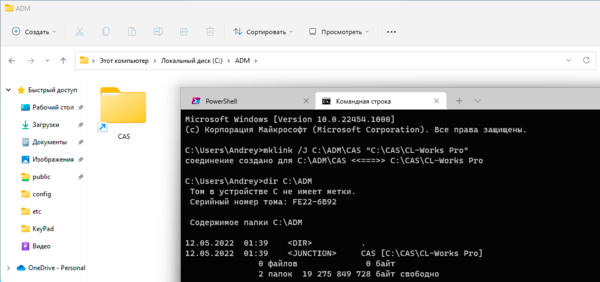
Это же действие в PowerShell:
New-Item -ItemType Junction -Path D:\LinkFolder -Target C:\FolderКомментировать здесь особо нечего, краткость не входит в число добродетелей PowerShell, но не оставляет места догадкам, все просто и понятно.
Зачем сейчас нужны точки соединения? После появления в NT 6.0 настоящих символических ссылок не нужны, но вы можете встретиться с ними как в устаревших системах, так и в современных, где они могут присутствовать в виде наследия. Поэтому знать о них и уметь с ними работать современному администратору надо.
Символические ссылки (SymbolicLink)
Пожалуй, самый популярный вид связи, позволяет создавать множество псевдонимов для файлов или каталогов размещая их на любых поддерживаемых локальных файловых системах. В качестве цели могут быть использованы как локальные, так и сетевые объекты. При создании символической ссылки можно использовать как абсолютные, так и относительные пути. Но в последнем случае вы не можете перемещать ссылку — она перестанет работать. Символические ссылки поддерживаются начиная с NT 6.0 (Vista и Server 2008) и работают с файловыми системами NTFS и ReFS.
Для создания символических ссылок можно использовать mklink, без параметров она создает симлинк для файла:
mklink C:\Folder1\LinkFileName C:\Folder\FileNameПри создании ссылки не забываем указать расширения для файла. Как и в случае с точкой соединения символическая ссылка отображается в виде ярлыка и обозначается в выводе команды dir:
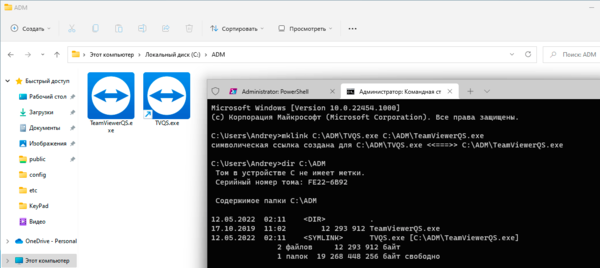
Для создания символической ссылки на директорию добавьте ключ /D:
mklink /D D:\LinkFolder C:\FolderВ PowerShell все проще, тип объекта будет определен автоматически:
New-Item -ItemType SymbolicLink -Path C:\Folder1\LinkFileName -Target C:\Folder\FileNameЕсли в качестве цели указан файл — будет создана ссылка на файл, каталог — ссылка на каталог.
При переименовании, перемещении или удалении исходного файла или каталога все символические ссылки работать перестанут:
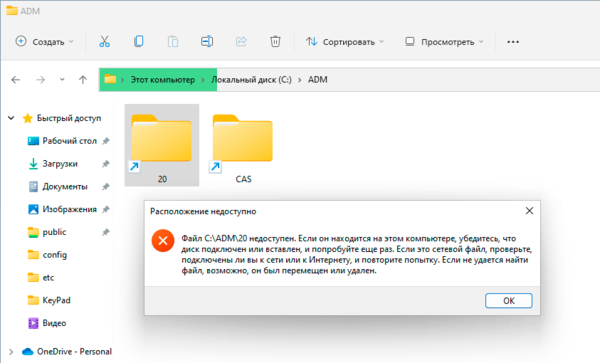
При копировании символической ссылки за пределы локального тома будет скопирован исходный файл, даже если целевой том поддерживает работу со ссылками, но это не мешает создать новую ссылку на другом томе.
Онлайн-курс по устройству компьютерных сетей
На углубленном курсе «Архитектура современных компьютерных сетей» вы с нуля научитесь работать с Wireshark и «под микроскопом» изучите работу сетевых протоколов. На протяжении курса надо будет выполнить более пятидесяти лабораторных работ в Wireshark.
Did you know that Windows has supported symlinks since Vista? You can create them using the Windows Command Prompt.
🔗 What Are Symlinks?
Symbolic Links are basically advanced shortcuts that you create on the command line. Once created, Windows treats them just the same as if they were a normal folder.
For example, let’s say you have a program that needs its files at C:\MyProgram, but your C: Drive is dangerously low on space and you’d prefer to install that program on another drive, but it throws errors whenever you try to install it there. For the sake of this argument, we’re going to pretend that the installer will allow you to install to an existing directory — so that one way you could solve this problem would be to create a folder called D:\Stuff\MyProgram, and then create a symbolic link at C:\MyProgram which points to D:\Stuff\MyProgram. Now, once you’ve installed the program and launch it, when it tries to access C:\MyProgram, Windows will automatically redirect it to D:\Stuff\MyProgram, and your program will never know the difference!
This trick can be used for all sorts of things — including syncing any folder with programs such as Dropbox, Google Drive, and OneDrive.
There are two types of Symbolic Link — Hard and Soft. Soft Symbolic Links work similarly to a Windows Shortcut. When you open a soft link to a folder, you will be redirected to the folder where the files are stored — which would probably not be suitable in our example above. A hard link, however, makes it appear as though the file or folder actually exists at the location of the symbolic link, and your applications won’t know the difference. I find myself using hard links as my default in most situations — but you can make up your own minds as to which you want to use where.
Windows uses slightly different terms here though. Instead of «hard link» and «soft link», Windows uses the terms «hard link» and «symbolic link». According to the Windows documentation, a «symbolic link» is exactly the same as a «soft link», and the mklink command is what you need to use to create both kinds.
💻 Creating Symbolic Links with mklink
Firstly, open a Command Prompt in Administrator Mode:
- Click on the
Startbutton - Scroll down to the
Windows Systemfolder in the Start Menu - Right-click on the
Command Promptshortcut and selectRun as Administrator
By default (without any additional options), the mklink command will create a Symbolic Link (or «soft link») to a FILE. The command below creates a symbolic («soft») link at <link> pointing to <target> (you know NOT to type the angle brackets, right?):
To create a symbolic («soft») link to a target DIRECTORY, use the /D option:
mklink /D <link> <target>
To create a «hard link» to a FILE, use:
mklink /H <link> <target>
And to create a «hard link» to a DIRECTORY (also known as a «directory junction»), use:
mklink /J <link> <target>
So, for example, if you wanted to create a directory junction («hard link» to a folder) at C:\LinkToFolder which points at C:\Users\Username\TargetFolder, you’d use the following command:
mklink /J C:\LinkToFolder C:\Users\Username\TargetFolder
If any of your paths have spaces in them, just put quotation marks around them:
mklink /J "C:\Link To Folder" "C:\Users\Username\Target Folder"
If you see the error message «You do not have sufficient privilege to perform this operation», it means that you haven’t launched the Command Prompt (or whatever it is you’ve used) as an Administrator before running the command … (which means you’re rushing things and need to slow down a little, because I DEFINITELY told you that in the first step!)
🚫 Deleting Windows Symlinks
The good news is that Windows Symlinks can be deleted just like any other file or folder from the Command Prompt, Windows Explorer, and any third-party package you might care to use.
Quick Links
-
How to Create Symbolic Links with mklink
-
How to Create Symbolic Links with a Graphical Tool
-
How to Delete Symbolic Links
Summary
- Symbolic links are advanced shortcuts in Windows 11 and Windows 10 that can point to a file or folder, redirecting applications to access them as if they were in a different location.
- There are two types of symbolic links: soft links, which redirect to the location where files are stored, and hard links, which make it appear as though the file or folder exists at the location of the symbolic link.
- Symbolic links can be created using the mklink command in Command Prompt, with different options for creating symbolic links to files or directories. Alternatively, you can use the Link Shell Extension, a graphical tool, to create symbolic links with more options.
Windows 11 and Windows 10 both support symbolic links — also known as symlinks — that point to a file or folder on your system. You can create them using the Command Prompt or a third-party tool called Link Shell Extension.
What Are Symbolic Links?
Symbolic links are basically advanced shortcuts. Create a symbolic link to an individual file or folder, and that link will appear to be the same as the file or folder to Windows — even though it’s just a link pointing at the file or folder.
For example, let’s say you have a program that needs its files at C:\Program. You’d really like to store this directory at D:\Stuff, but the program requires that its files be at C:\Program. You could move the original directory from C:\Program to D:\Stuff, and then create a symbolic link at C:\Program pointing to D:\Stuff. When you relaunch the program, it will try to access its directory at C:\Program. Windows will automatically redirect it to D:\Stuff, and everything will just work as if it were in C:\Program.
This trick can be used for all sorts of things, including syncing any folder with programs like Dropbox, Google Drive, and OneDrive.
There are two type of symbolic links: Hard and soft. Soft symbolic links work similarly to a standard shortcut. When you open a soft link to a folder, you will be redirected to the folder where the files are stored. However, a hard link makes it appear as though the file or folder actually exists at the location of the symbolic link, and your applications won’t know any better. That makes hard symbolic links more useful in most situations.
Note that Windows doesn’t actually use the terms «hard link» and «soft link». Instead, it uses the terms «hard link» and «symbolic link». In the Windows documentation, a «symbolic link» is the same thing as a «soft link». However, the mklink command can create both hard links (known as «hard links» in Windows) and soft links (known as «symbolic links» in Windows).
How to Create Symbolic Links with mklink
You can create symbolic links using the mklink command in a Command Prompt window as Administrator or as a regular user. To do this without an Administrator Command Prompt window, you must first enable Developer Mode from Settings > Update & Security > For Developers.
To open Command Prompt as admin, click the Start button, search «cmd» or «Command Prompt,» then select «Run as Administrator».
Windows 11 doesn’t require administrative privileges to create symbolic links.
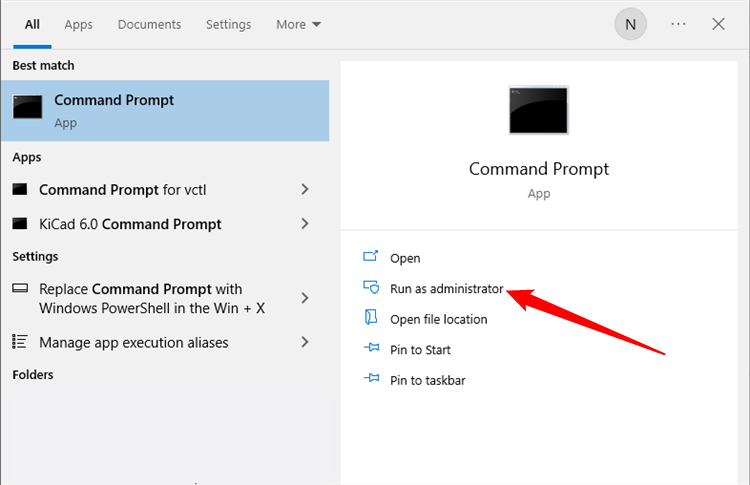
Without any extra options, mklink creates a symbolic link to a file. The below command creates a symbolic, or «soft», link at Link pointing to the file Target :
mklink Link Target
Use /D when you want to create a soft link pointing to a directory. like so:
mklink /D Link Target
Use /H when you want to create a hard link pointing to a file:
mklink /H Link Target
Use /J to create a hard link pointing to a directory, also known as a directory junction:
mklink /J Link Target
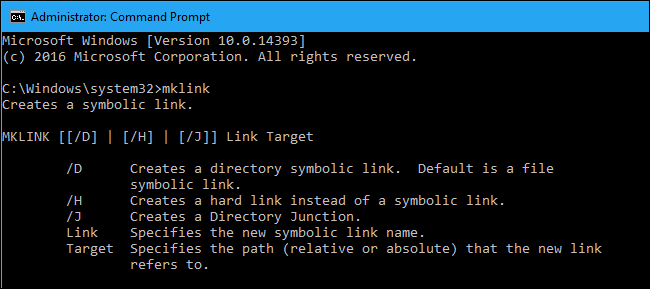
So, for example, if you wanted to create a directory junction (a hard link to a folder) at «C:\LinkToFolder» that pointed to «C:\Users\Name\OriginalFolder,» you’d run the following command:
mklink /J C:\LinkToFolder C:\Users\Name\OriginalFolder
You’ll need to put quotation marks around paths with spaces. For example, if the folders are instead named «C:\Link To Folder» and «C:\Users\Name\Original Folder,» you’d use the following command instead:
mklink /J "C:\Link To Folder" "C:\Users\Name\Original Folder"

If you see the message «You do not have sufficient privilege to perform this operation.», you need to launch the Command Prompt as Administrator before running the command.
If you’re like to do this with a graphical tool, download Link Shell Extension. Be sure to download the appropriate prerequisite package before the tool itself — both are linked to on the tool’s download page.
Once it’s installed, locate the file or folder you want to create a link to, right-click it, and select «Pick Link Source» in the menu.
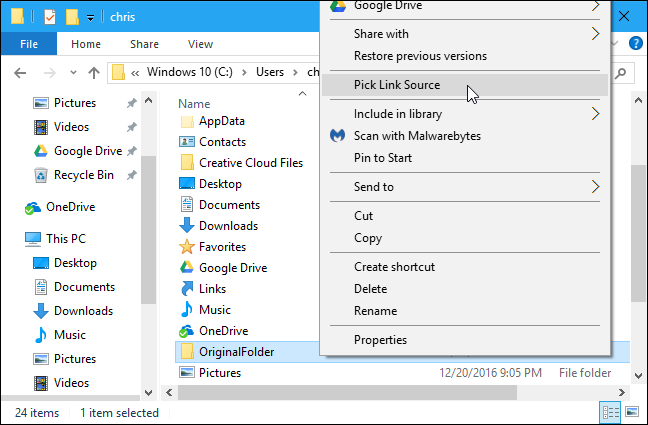
You can then right-click inside a different folder, point to the «Drop As» menu and select «Hardlink» to create a hard link to a file, «Junction» to create a hard link to a directory, or «Symbolic Link» to create a soft link to a file or directory.
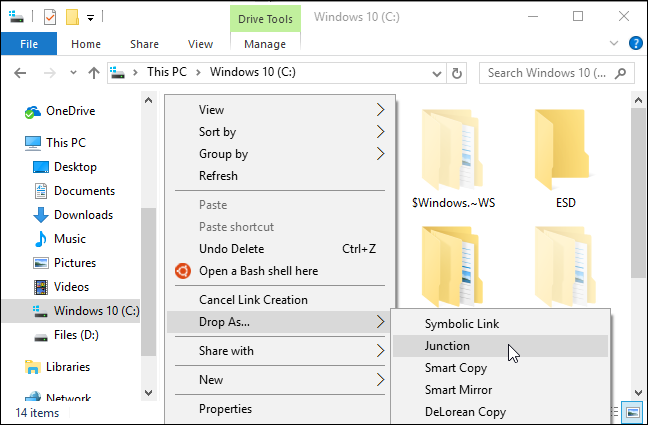
How to Delete Symbolic Links
To get rid of a symbolic link, you can simply delete it like you would any other file or directory. Just be careful to delete the link itself rather than the file or directory it’s linking to.
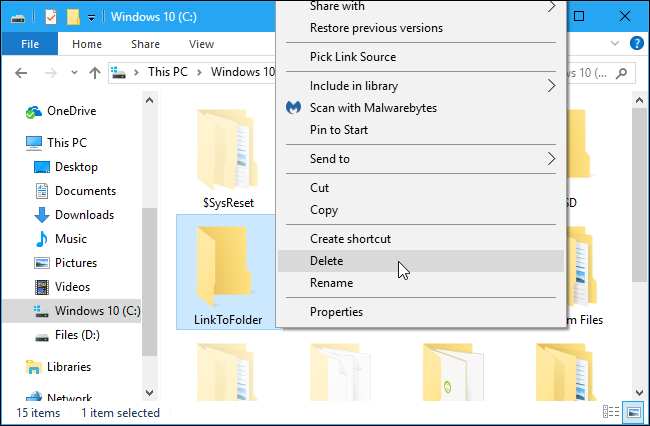
That is a major advantage of a symbolic link — you can freely delete the symbolic link whenever you want without worrying about the associated files or folders.
Last Updated :
08 Sep, 2020
A symbolic link is used to describe a file, that doesn’t store any data. Symbolic Links on Windows contains a reference to another file or directory in the respective of an absolute or you can say to the relative path. The type of path (relative/absolute) is defined during the creation of the link.
Most operating systems offer support for Symbolic Links in one way or another. Linux and Windows both provide support for generic Symbolic Links with some OS exclusive features, i.e. Windows allows for the creation of Junction points which are folder soft links with a little different working. In this article, we will take a look at the creation of symbolic links on Windows using mklink command found in the command processor (cmd) of the OS.
Note –
The command requires administrator privileges to execute.
Types of symlinks :
- Hard Links
- Soft Links
Description of the command :
MKLINK [[/D] | [/H] | [/J]] Link Target
/D Creates a directory symbolic link. Default is a file
symbolic link.
/H Creates a hard link instead of a symbolic link.
/J Creates a Directory Junction.
Link Specifies the new symbolic link name.
Target Specifies the path (relative or absolute) that the new link
refers to.
Note –
The above text could be obtained by executing the mklink command without any arguments.
Creating a soft link to a file :
In order to create a soft link, the syntax of the command is:
mklink Link_path Target_path
- Where Link_path is the name (or path) to the symbolic link which is to be created.
- Target_path is the path which the new link will refer to.
Example –
There exists the a file with the path C:\suga\settings
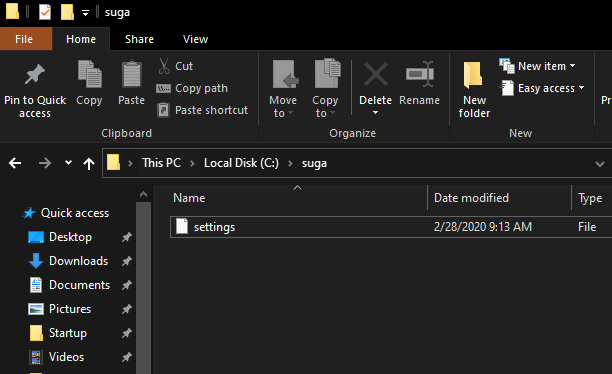
In order to create a soft link of the file on the same path with a different name (ex. apple), the command would look as follows.
mklink "C:\suga\apple" "C:\suga\settings"
Note –
In the above command, both paths are absolute.
After the execution of the above command, a soft link to the file will be created appears as follows.

The same method could be used for creating a soft link to a directory as well, the only difference being that the /D switch needs to be added to the command.
making the syntax :
mklink /D Link_path Target_path
Creating a hard link to a file :
In order to create a soft link, the syntax of the command is as follows.
mklink /H Link_path Target_path
Example –
In this example, we would use the same file as the one used in the last example, located at C:\suga\settings. In order to create a hard link of the file at the same path with a different name (ex. moba) the command would look as follows:
mklink /H "C:\suga\moba" "C:\suga\settings"
After the execution of the above command, a hard link to the file will be created appearing as follows :

Hard links could not be created for directories, therefore unlike the previous example, both paths (Link & Target) should point to a file only.
